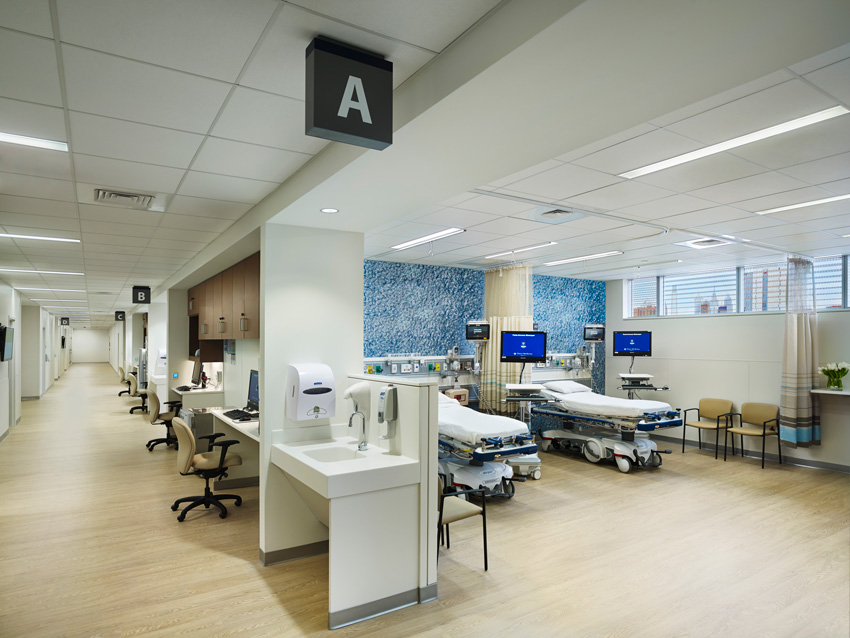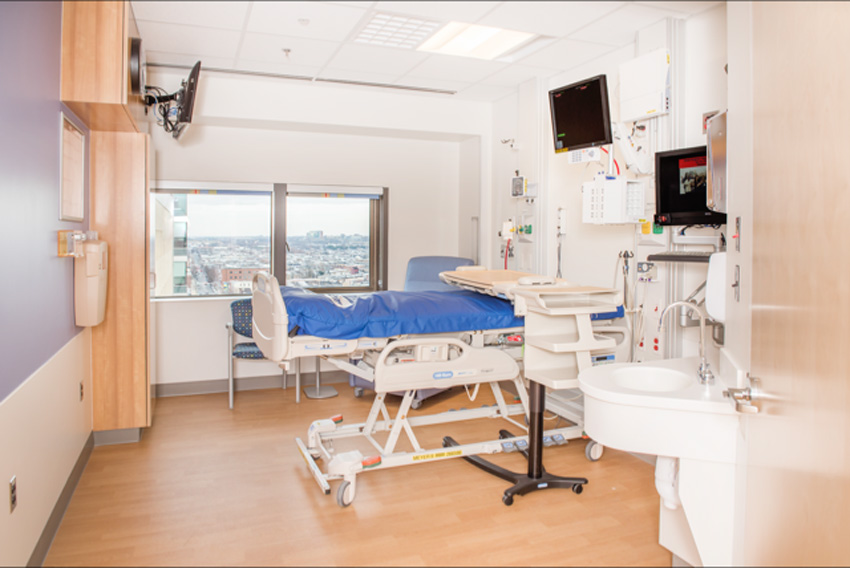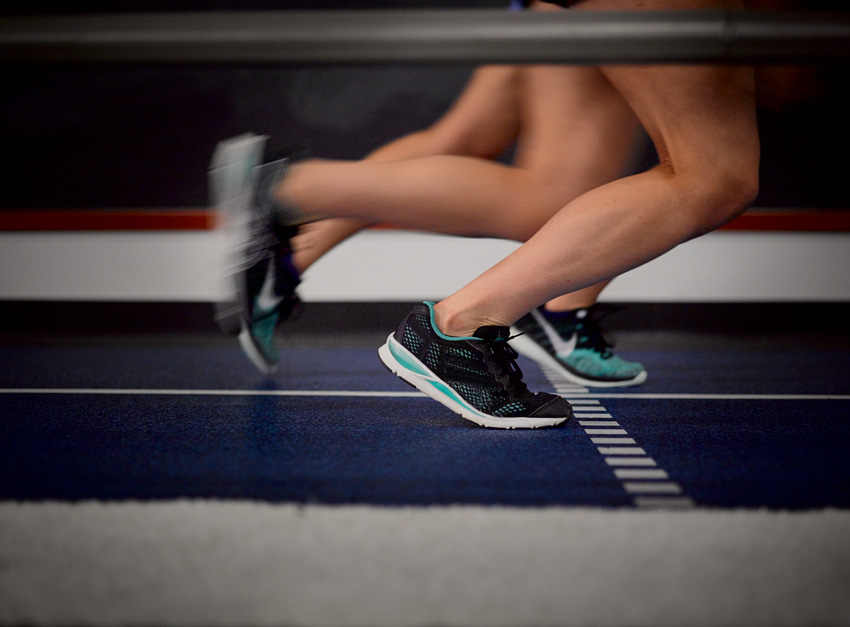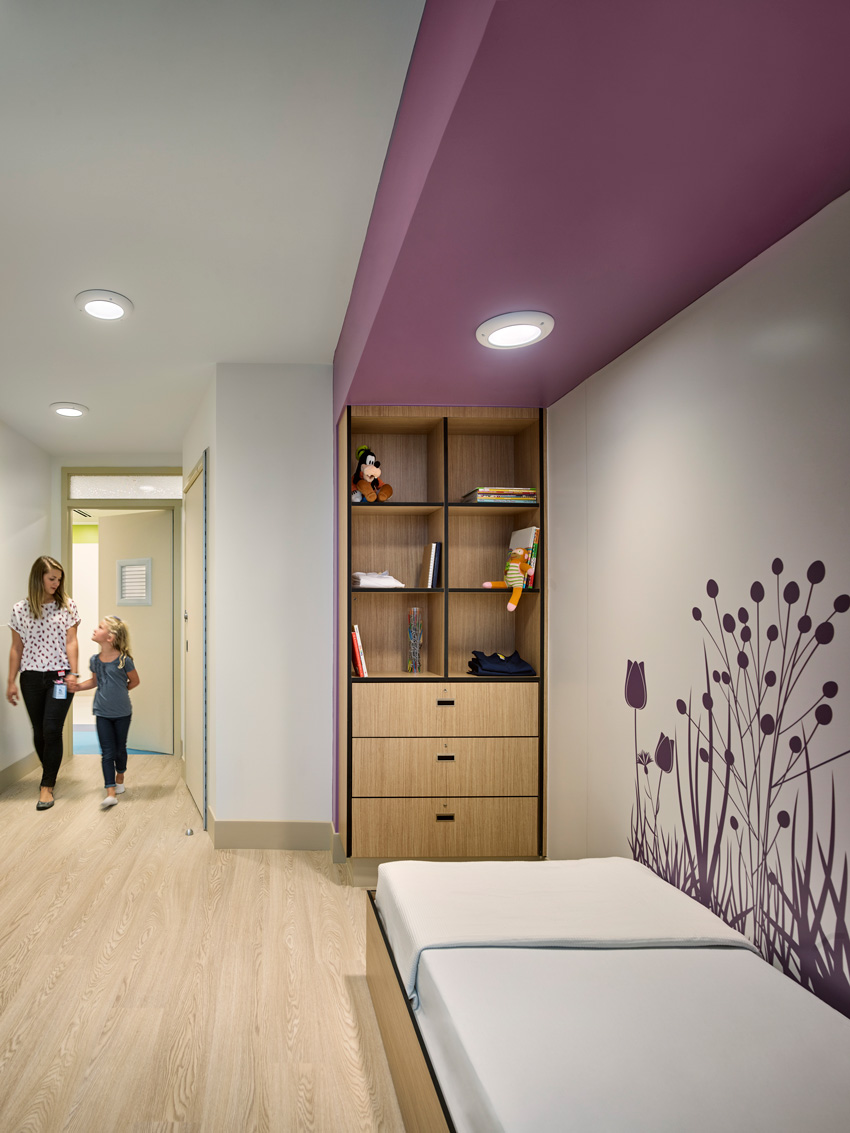Defining Performance in Flooring
Performance Floors: Safety

Today, more people are more active, a positive development in society. But more activity means more falls. Flooring can reduce the force of impact and help to prevent falls and mitigate injury when falls do occur. Shown here is the engineered performance flooring in Pennsylvania Presbyterian Medical Center, Philadelphia.
The term “safety floor” typically refers to flooring used to improve traction in areas that are likely to be exposed to water, food, or chemicals, such as industrial spaces, commercial kitchens, pools, or spas. But safety is also a much broader category of performance, and it is a vital concern in almost every kind of space. For example, in the hospitality industry, a range of indoor and outdoor activities and playgrounds have become an essential offering by most hotels today, a major part of what they are doing to increase the wellness and satisfaction of guests. It becomes critical to the company’s operation to protect these guests.
In some applications, safety receives even greater emphasis, such as flooring for schools, hospitals, athletic facilities, and many different types of rehabilitation, independent, and assisted living facilities. A performance floor should contribute to reducing impact hazards in the space, balanced with enhancing the ability of people to move freely.
Floors can also be designed for other uses that relate to safety. Changes of color and pattern can be designed to indicate changes of level, aid in wayfinding, or assist people with visual impairments. Floors are major components of design in health-care environments, where the creative use of color and beauty has been proven to enhance patient experience, support healing, and improve outcomes.
Slip resistance, often measured by COF, is probably the most familiar component of safety performance in flooring and one of the most important for selecting flooring that reduces the likelihood of a fall by preventing slips. Collectively, the flooring industry has made significant strides bringing down the number of falls. But falls do inevitably occur, and since they can never be eliminated entirely, a performance floor should also work to prevent injury or reduce its severity.
At the same time, depending on the exact application, a surface that is too slip resistant can be inefficient and present a safety hazard of its own when it impedes movement. The users of a gym, dance floor, corporate lobby, retail store, or classroom will need support and protection with different balances of slip resistance and mobility.
Concepts often used in specifying surfaces for sports, fitness, and athletics, such as playability, sliding effect, and head injury criterion, are useful in thinking about surfaces in many other types of spaces too. For example, standards for sports surfaces describe criteria for measuring factors in addition to COF, such as sliding effect, shock absorption, vertical deformation, and ball bounce. These characteristics affect both safety and playability—a player’s stability and freedom of movement. The concept of playability is a useful idea when evaluating how suitable a floor will be for the specific activities in the space.
Today, more people are more active, an extremely positive development in society. But more activity comes with more falling; this is as human as kids learning to walk. “The floor can make an immense and possibly life-changing difference in preventing and mitigating injury,” says Mark Huxta, director of health-care sales for Ecore.
Safety performance is also closely related to ergonomic performance. For example, when Johns Hopkins Hospital in Baltimore decided to replace carpet throughout its facilities, it conducted a system-wide, multidisciplinary research floor testing study in 2014–2015, comparing 20 products according to numerous criteria, including reduction of risk of injury associated with falls, sound control, sustainability, effective cleaning, comfort underfoot, and many others. The surface selected for inpatient rooms in the JHH Meyer Neuro & Rehab facility is an engineered surface of vinyl sheet fusion-bonded to a 5-millimeter composition rubber backing.

The engineered flooring surface at JHH Meyer Neuro & Rehab facility in Baltimore features vinyl fusion bonded to composition rubber backing.
The following are key terms and criteria for evaluating safety performance in flooring. Many also apply to ergonomic performance, discussed in the section above. In some applications, specific scores or ratings may be required. In others, manufacturers should be able to discuss how these concepts can inform the comparison of different flooring products.
Key Safety Terms and Criteria
- Coefficient of friction (COF): A measure of slip resistance, part of an overall consideration of how people will use the surface, to ensure both safety and ease of movement. In the United States, the most common test method for resilient floors is ASTM D2047. The pendulum standard first developed in Britain has become the basis for national slip resistance standards in many countries but is not yet used widely in the United States. Measuring slip resistance precisely is a subject of ongoing discussion. Flooring manufacturers should be able to offer information about test methods used to measure the performance of their products.
- Sports floor classes: ASTM F2772: Standard Specification for Athletic Performance Properties of Indoor Sports Floor Systems establishes criteria for sports or multipurpose flooring, defining classifications from Class 1 to 5, according to shock absorption, vertical deformation, ball bounce, and sliding effect. Class 1 is not necessarily “better” in an absolute sense. For example, a rigorously designed competitive professional basketball court might be a Class 2 because of the overall balance of considerations and the nature of the play and the players.
- Ball bounce: The higher a ball will rebound, the better the playability. In the surface testing process, a ball is dropped from a given height onto a surface and must bounce back at a certain required height in order to be approved for play.
- Sliding effect: How a surface prevents slipping but allows for safety of movement.
- Vertical deformation: How much the floor will deform, or “give” on impact. Measures the deflection of a surface during an entire impact. Also referred to as a “stiffness test,” a measure of foot stability, indicating what a person feels on his or her feet. An important criterion in health-care settings to gauge how easily and safely staff will be able to maneuver beds and equipment like rolling carts.
- Head injury criterion (HIC): A measure of the likelihood of head injury arising from an impact. The HIC can be used to assess safety in many different areas, such as vehicles, personal protective gear, sports equipment, and surfaces. For playing surfaces, the HIC test measures the force of a human head when it strikes the surface. The higher the Critical Fall Height (CFH), in meters, the more protective the surface. For example, a CFH rating of 6 means the surface is equipped to reduce the likelihood of an injury occurring from up to a 6-foot fall. The higher the CFH rating, the safer the surface.
- G-Max: A measure of how field surfaces (typically synthetic) perform in terms of impact attenuation or shock absorption. ASTM Standard F355-A and ASTM Specification F1936 tests measure how many Gs (gravitation-force, basically measuring acceleration) a surface can absorb upon impact. For example, in the case of a playing field, higher G-max means the surface absorbs less impact and returns more to the player. A lower G-max score reduces the likelihood of injury.

Concepts often used in specifying surfaces for sports, fitness, and athletics, such as playability, sliding effect, and head injury criterion, are useful in thinking about surfaces in other types of spaces.
What Can A Floor Do?

Every floor should make a positive contribution to the performance and well-being of the people using it.
As discussed in this course, a thoughtfully designed floor using state-of-the-art advances in materials and manufacturing can “do” quite a lot in terms of safety, ergonomics, and acoustics. A performance floor is a surface that responds to the users in its environment in ways that support and enhance their activities.
At the same time, these floors still need to meet the most fundamental requirements of premium flooring in all types of interiors. In addition to adding new performance capabilities, the quality of flooring products should also be evaluated by traditional measures of performance, including:
- Aesthetics and design versatility: New performance flooring offers a wider variety of design possibilities because the wear surface can be composed of many different materials, including vinyl, rubber, turf, and carpet, in an almost unlimited range of finishes, colors, patterns, and textures, from floors that reproduce natural wood grains to floors with custom-designed graphics.
- Durability: Long-term performance with low need for replacement. Performance flooring can be selected with increased energy restitution for durability under particularly demanding conditions, such as high-impact weights or high traffic.
- Maintenance: Performance flooring products are available with a factory-applied reinforcing finish that provides polish-free maintenance for the lifetime of the product. Performance flooring helps manage life-cycle costs while assuring clean, sterile environments where necessary.
- Sustainable life cycle and visible corporate commitment to environmental responsibility. Some of the major criteria for assessing sustainable performance flooring products include:
- Contribution to LEED points by meeting criteria under Material and Resources and Indoor Environmental Quality categories;
- FloorScore rating;
- Environmental product declarations (EPDs); and
- Participation in the Mindful Materials program, a design industry initiative that provides a single common platform for manufacturers to communicate—and designers to access—information such as disclosure documents and certifications for specific products.

|
At Ecore, we are driven by this question: Can a floor do more? We believe the answer is YES! We are building our company and the products we offer based on the simple notion that floors should elevate beyond current expectations. We engineer performance well beyond industry standards related to acoustics, ergonomics, and safety. www.ecoreintl.com |








